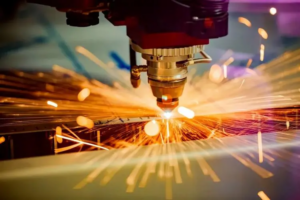What are the protective gases for metal laser cutting?
Laser cutting technology is widely used in the processing of metal and non-metal materials, which can greatly reduce processing time, reduce processing costs, and improve workpiece quality. Modern lasers have become the "sword" that people dream of "cutting iron like mud". The laser cutting machine requires an air source as power when working, and it is a pressurized air source. The laser beam is irradiated onto the surface of the workpiece, causing the workpiece to reach the melting point or boiling point. At the same time, the high-pressure gas coaxial with the beam will blow away the melted or vaporized metal.
The "tool" used in laser processing is a focused light spot. There is no need to add other equipment and materials. As long as the laser can work normally, it can be processed continuously for a long time. Laser processing is fast and low-cost.
So, what are the protective gases for metal laser cutting machines?
Analysis of cutting protective gas for metal laser cutting machine:
Laser cutting machines use different auxiliary gases to cut different materials. Common auxiliary gases include: air, oxygen, nitrogen, and sometimes argon. For example: oxygen is used to cut carbon steel, and its purity requirement is generally 99.5% or higher. Its main function is to support combustion and blow away the cutting molten material. Depending on the thickness of the cutting material, the pressure and required flow rate of the auxiliary gas are different. The pressure and flow rate of each laser cutting machine manufacturer are different, which is closely related to the size of the cutting nozzle and the thickness of the cutting material.
Laser cutting machines use auxiliary gas when processing products. The auxiliary gas is mainly used in the laser generator to generate laser gas; compressed air is generally used to protect the optical path. The auxiliary gas is the gas sprayed from the cutting nozzle of the cutting machine. The auxiliary gas of the metal laser cutting machine acts to support combustion and dissipate heat, promptly blowing off the molten stains produced by cutting, preventing the cutting molten stains from rebounding upward into the nozzle, and protecting the focusing lens.
Nitrogen is used to cut stainless steel. Its function is to prevent oxidation reactions and blow off the molten material. It has high requirements for the purity of nitrogen (especially stainless steel above 8mm, which generally requires a purity of 99.999%). The pressure requirements are relatively large, and general requirements At 1Mpa, if you want to cut stainless steel of 12mm or more, or 25mm thicker, you need a higher pressure, 2Mpa or more. In terms of cost, oxygen for cutting carbon steel is relatively cheap, while cutting carbon steel requires a large amount of nitrogen. The thicker the stainless steel, the higher the amount and purity of nitrogen, the higher the cost.
1. Metal laser cutting machine cutting protective gas compressed air
Since compressed air mainly acts on the lens of the laser cutting machine head, if it contains oil or water, it will inevitably cause pollution to the lens. In severe cases, it will reflect the laser, causing the collimator mirror, focusing mirror, and laser head to burn out. Therefore, the quality of compressed air is also an important factor affecting the quality of laser cutting final molded parts.
2. Metal laser cutting machine cutting protective gas nitrogen
Nitrogen is an inert gas that can protect the laser cutting surface very well, but because it blocks oxygen, it reduces the processing efficiency.
3. Metal laser cutting machine cutting protective gas oxygen
Oxygen can support combustion, but due to the strong oxidizing property of high-purity oxygen, the cut surface will turn black and increase in hardness, which is commonly known as "scorched". Therefore, air with an oxygen-to-nitrogen ratio of about "30-70" has become the best choice for laser cutting in general processing.
4. Metal laser cutting machine cutting protective gas argon
Argon, like nitrogen, is an inert gas and can also prevent oxidation and nitridation during laser cutting. Generally, it is extremely uneconomical to use argon for ordinary laser cutting. Argon gas cutting is mainly used for titanium and titanium alloys.








